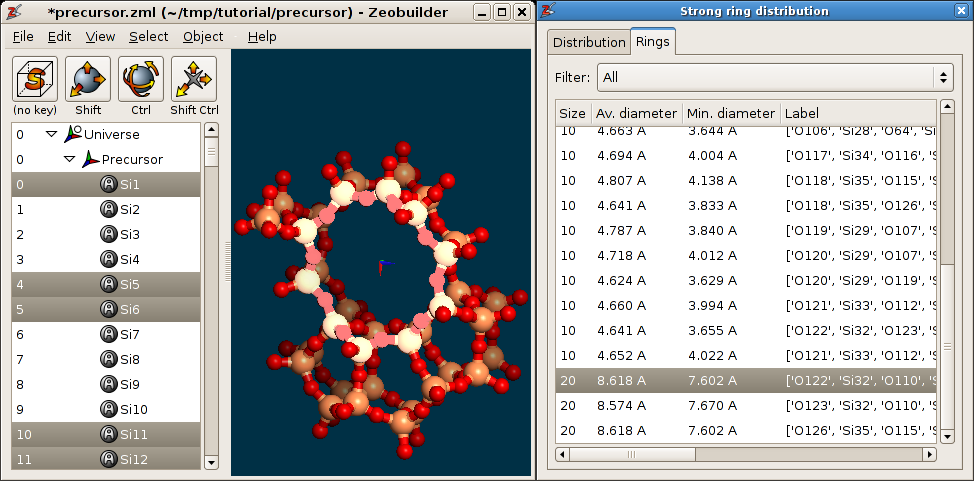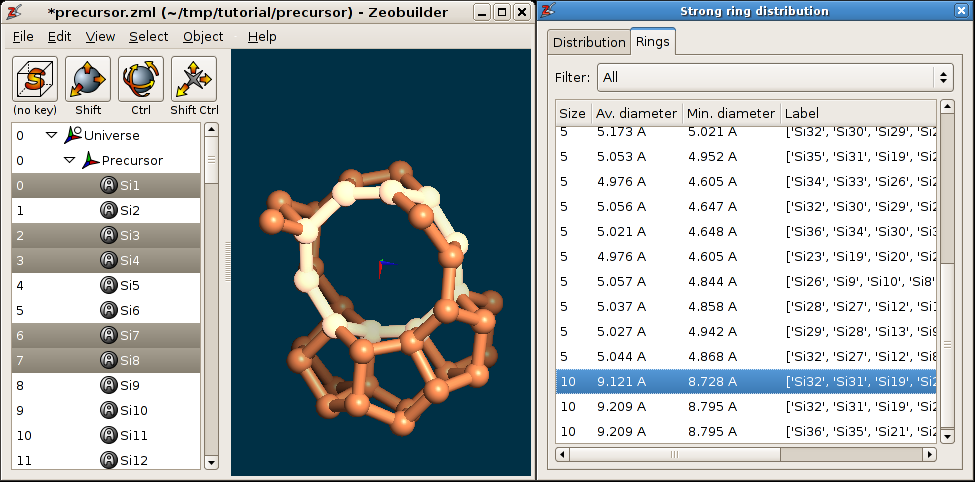5.2. Topological analysis¶
In the sections below, several zeolite models can be used:
sod_cage.zml, precursor.zml and silicalite1.zml.
5.2.1. T-atom coordination¶
The fraction of Q1, Q2, Q3 and Q4 T-atoms is conventional measure for the crystalinity of silica. In Zeobuilder, this information is obtained in two steps:
- Open one of the example models and select the global reference frame.
- Activate the menu function
Object -> Molecular -> T-atom coordination. A popup dialog will appear, similar to this figure:

The t-atom coordination dialog
The Select buttons close the dialog and selects all the corresponding Qx
atoms.
5.2.2. Strong rings¶
In addition to the previous analysis, the enumeration of the strong rings is an common method to clasify a zeolite model. For more information about rings in crystal topologies, read the book Crystal Structures by M. O’Keeffe and B. G. Hyde, in particular chapter 7. A few essential concepts are defined below:
- Vertex
- A node in a graph. Vertices are connected by edges. In molecular topologies, vertices are atoms.
- Edge
- A link in a graph. Edges connect vertices. In molecular topologies, edges are bonds.
- Path
- A consecutive series of edges. A path connects two end vertices, via one or more consecutive edges.
- Cycle
- A path where the end vertices coincide. It starts where it begins.
- Ring
- A cycle for which no short cuts exist in the topology. Note that the definition of a ring also uses vertices and edges that are not part of the ring itself.
- Strong ring
- A ring that can not be decomposed in smaller rings.
The enumeration of strong rings in Zeobuilder, takes the following steps:
- Open one of the example models and select the global reference frame.
- Activate the menu function
Object -> Molecular -> Strong ring distribution.
The results are presented in a window as shown in the figure below. The first tab contains a histogram of the strong ring distribution, while the second tab explicitly lists all strong rings. When selecting a strong ring from this list, the corresponding atoms are selected (and hence highlighted in the 3D view).

The strong ring distribution of the MFI precursor
We must give a few remarks here:
- The ring distribution code does not take into acount the periodicity of the system. For example, when the strong ring distribution is applied to the MFI structure, the analysis will list certain cycles that are clearly not strong rings.
- In the context of zeolites, a ring that contains 10 atoms, is actually a 5T-ring. This annoyance can be circumvented, as shown in the following figure. Try to reproduce this.

The strong ring distribution of the MFI precursor, without oxygen atoms.
